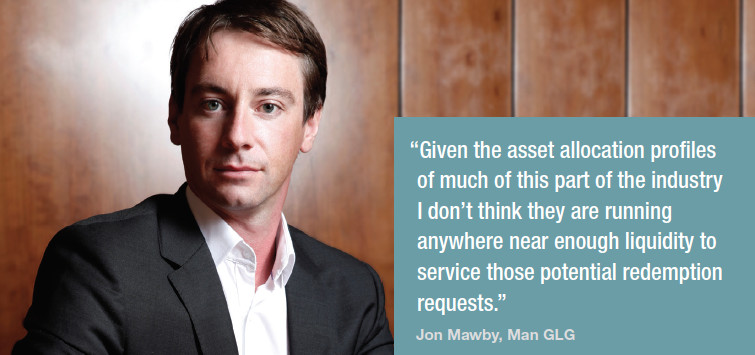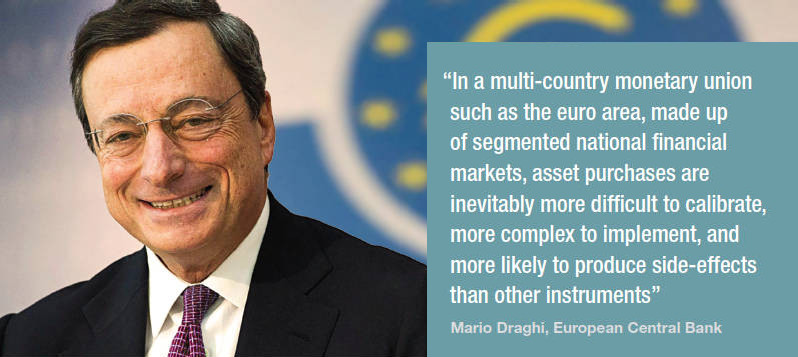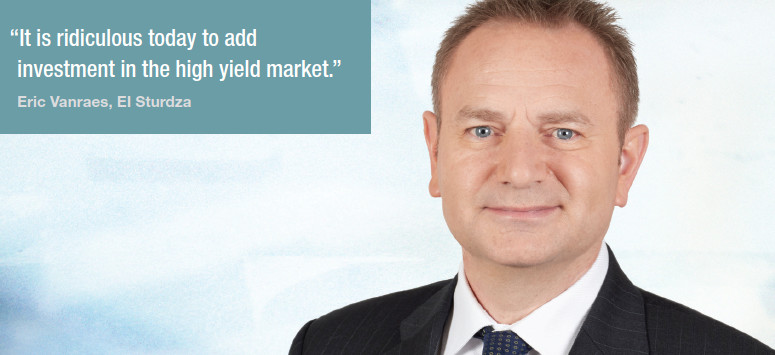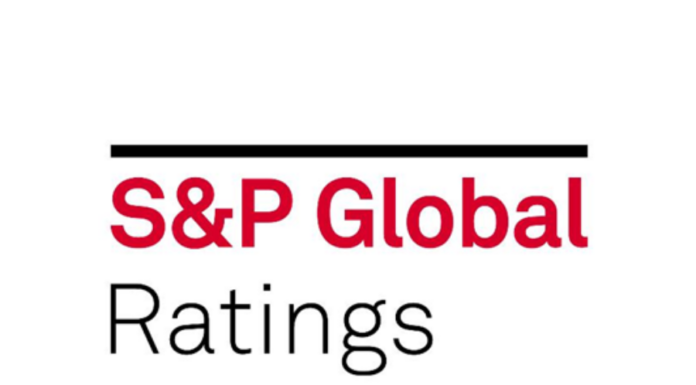Fixed income portfolios need to be reassessed in preparation for the end of asset purchasing programmes. Dan Barnes reports.
Quantitative easing has wound up an enormous spring of liquidity in corporate and government bond markets as central banks bought these assets. Handling the whiplash, as central bank investment in the fixed income markets is unwound, requires asset managers to carefully balance portfolio construction and trading strategy. If the bond market does face a major liquidity event, closure of asset purchasing programmes are seen by some as a likely trigger.

“Whereas I think the 2007 crisis was a case of private sector leverage that exacerbated the situation, I would say in this instance it’s a case of public sector leverage,” says John Porter, global head of fixed income at AXA Investment Managers, which has Ä669 billion in assets under management. “I don’t put any kind of blame on the central bank because I think they are trying to act in the best interests of the overall economies. However at times there are unintended consequences.”
A liquidity shock is likely to be borne by daily-dealing bond funds. Run by major asset management firms and hedge funds alike, those funds with a daily liability to their investment desk, in order to meet daily redemptions, have the greatest exposure to liquidity risk.

Jon Mawby, senior portfolio manager at Man GLG, which has US$28.8 billion funds under management says, “If you were a structured investment vehicle in 2007 you may have had anywhere between one and six months to meet your repo obligations. You knew they were probably rolling off, you knew they weren’t likely to be extended, and you had that time, albeit in a challenging market, to actually sell the assets.”
The present situation under QE has changed the situation, making the liquidity risk more acute.
Mawby continues, “If you suddenly start to get net outflows from fixed income the environment is unlikely to be markedly different from 2008 only this time the issue has shifted from the SIVs to daily liquidity funds. Given the asset allocation profiles of much of this part of the industry I don’t think they are running anywhere near enough liquidity to service those potential redemption requests. In essence the asset liability mismatch has shifted from the SIVs to the daily dealing sector.”
Handling imbalances between obligations takes a measure of portfolio optimisation, in order to reduce exposure to impacted assets, and trading savvy in order to handle a range of instruments that can help to manage liquidity risk. But confidence is not high – one buy-side trading desk said its firm did not want to discuss “something so subjective and unpredictable.”
Porter notes that while certain instruments can be used by trading desks to handle low liquidity, a complete mismatch between actual positions and desired positions in a liquidity event could lead to a market breakdown.
The QE situation
The Bank of England launched an 18-month QE programme, with purchase targets of £60 billion government bonds and £10 billion corporate bonds, in September 2016. Both limits have been reached, on 1 February and 27 April 2017, with redemptions reinvested to maintain the stock of purchases.
The European Central Bank’s QE programme had accumulated Ä1.8 trillion in assets by the end of April 2017, and is making monthly net purchases in both public and private sector bonds amounting to an average of Ä60 billion, dropping from the Ä80 billion per month which were being acquired between April 2016 to March 2017. The Eurosystem, the monetary authority of the Eurozone, has a stated aim of achieving inflation rates below, but close to, 2% through asset purchasing over the medium term. It says the programme will continue to the end of 2017 at the earliest.

On 24 May 2017, European Central Bank president Mario Draghi said in a speech that he saw “no reason to deviate” from the programme, while acknowledging that, “In a multi-country monetary union such as the euro area, made up of segmented national financial markets, asset purchases are inevitably more difficult to calibrate, more complex to implement, and more likely to produce side-effects than other instruments, including moderately negative rates.”
Such communications are deliberately imprecise. Given the flexibility that exists around QE, asset managers will need to be wary of the communication that the ECB and BoE issue on both the end of the QE and any rate hike.

“We still don’t know if the ECB will choose first to communicate on the tapering or to start raising this deposit rate,” says Eric Vanraes, portfolio manager at EI Sturdza, which has US$3 billion in AUM. “I am afraid they won’t be able to do both at the same time, it will be too much, but as of today with the information we have had they will probably follow the agenda and start tapering at the end of the year, and the beginning of next year.”
At that point the balance sheet of the bank will stabilise rather than shrink. The big question after that point, as it already is in the US now, will be when the central bank starts to shrink its balance sheet so bonds are redeemed in the portfolio.
“If there is a violent adjustment, what you would think should not be correlated sometimes becomes correlated,” says Porter. “During times of panic people effectively sell the good stock to finance their losses in the bad stock; the problem being a lot of institutions have invested significantly in relatively illiquid assets. The question is, what will happen if they try to get out, but cannot get out at any price at that point?”
Mawby adds, “Investors in daily dealing funds can get their money on a day’s notice, but a lot of these products are investing a substantial proportion of the assets in less liquid parts of the fixed income universe, where the window of exit can be tiny, and the volume of money that may try and go through the door could be huge.”
Defensive measures
For the PM, protecting a portfolio against the impact of QE while maintaining performance requires careful assessment of the risks they would face in a specific event, set against cashflows generated.
“We have advised many investors wary of this scenario to invest in short duration; we wouldn’t necessarily have to be getting out of anything,” says Porter. “There could be a price adjustment at the time, but given the duration of the assets we would think that it would be more than compensated by the overall total return over time, particularly that which has been achieved already.”
Vanraes says his firm focuses on high quality, liquid assets and while avoiding correlation with the equity market as much as possible. In order to add performance and yield, fund managers must buy spread which he argues is correlated with equities, but with less liquidity and more risk, while the equity market offers more upside.
“It is ridiculous today to add investment in the high yield market,” says Vanraes.
He notes that PMs can invest carefully in bonds that represent value within a fund’s mandate while limiting exposure to the ECB. Euro-denominated bonds issued by non-Eurozone firms are one example and offer good returns.
Since the beginning of the year EI Sturda has started to take profit on some names and switched them into bonds denominated in Euro to fit the mandates, but for names that are not included in the asset purchasing programme.
“Corporate spreads are really too tight especially in the triple B universe,” he argues. “Recently we bought General Electric, which is double A minus, at a wider spread than Deutsche Telekom which is triple B rated. It is amazing to see a double A minus yielding more spread than a triple B.”
In an effort to generate the traditional fixed income profile of delivering income, diversifying from equities and protecting capital in times of stress, investment managers may use negatively correlated strategies.
Mawby says, “Fixed income portfolios are more directly positively correlated to equities than ever because central bank policy has shifted investors into riskier parts of fixed income which they traditionally might have avoided.”
He notes that could be achieved using more negatively correlated strategies such as credit and equity options, when volatility is apparently cheap as it is.
“Spending a little bit of the income you are generating on the portfolio particularly if you have got things like AT1s on the financial side, or corporate hybrids on the corporate side, I believe makes a lot of sense in seeking to produce a fund risk reward profile more in line with what investors have traditionally expected,” he says.
©Markets Media Europe 2025










